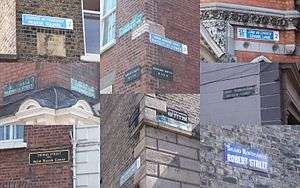Streets and squares in Dublin
This article deals with the streets and squares in Dublin and the Greater Dublin Area of Ireland.
Street naming
Most streets in Dublin carry names given during the period of English colonial rule. Some streets were renamed during the late colonial or Free State periods for Irish persons.
Street names fall into several categories. Many are named for persons such as British kings, queens, and their families, lords lieutenant, nobles, lord mayors, other state officials, Irish nationalist figures, celebrities, and property owners. Others are named for churches, public buildings, signs of public houses (taverns), places of historical note, places in London, occupations, and titles of office. A few are named for the physical characteristics of the street of the surrounding area and a few are corruptions of previous names.
Street names are modified with a number of terms. Generally, larger thoroughfare names include avenue, parade, road, and street. Smaller street names include alley, close, court, lane, mews, place, row, and terrace. Special locations or layouts include cottages, gardens, grove, hill, market, park, quay, square, villas, and yard and some these terms tend to be used more outside of the city centre.
Street signage

Dublin streets are signed in the British style with nearly all signs being placed on buildings adjacent to street junctions rather than on free-standing signposts. Dublin street signs have white lettering on a blue background with both the Irish and English names given along with the Dublin postal district number.
Address numbering
The system of building number generally follows the British pattern. With many streets (e.g., Grafton Street, Baggot Street Lower), numbers proceed sequentially up one side of the street to its terminus and then continue down the other side. The numbers usually begin in topographically lower areas and proceed upward, i.e., toward higher ground away from rivers. Other streets follow the pattern of even addresses on one side and odd numbers on the other. Unlike the usual North American style, each unit is given one number and no number is skipped. This results in situations where the odd numbers on one side and the even numbers on the other do not match due to differing numbers of buildings on the respective sides. For example, No. 2 Percy Place is directly across from No. 53 Percy Place because Grand Canal frontage delays the beginning of the even numbers. Addresses on squares usually ascend in a clockwise direction (although Parnell Square is anti-clockwise).
History
Dublin's earliest roads were four long-distance routes that converged on the Gaelic Ford of the Reed Hurdles (Áth Cliath) over the River Liffey. These were the Slige Chualann (roughly the route of the present day Harold's Cross Road) from Leinster in the south, Slige Dála (Crumlin Road) from Munster in the southwest, Slige Mór (Inchicore Road) from Connacht in the west, and Slige Midluachra (Dorset Street) from Ulster in the north.
The Vikings first established a fortified town at Dublin and its main street ran along what is now High Street and Castle Street.
Anglo-Norman Dublin maintained the basic Viking street plan and enlarged the town by expansion and land reclamation from the Liffey. The area north of present-day Cook and Essex streets was reclaimed during this time and provided with a relatively geometric street pattern. Streets became known for particular trades or activities and the names of several of these survive today (e.g., Winetavern Street, Cook Street, Fishamble Street, Ship Street [originally Sheep Street]). Most of the street layout within the old town walls dates from this period.
The first map of Dublin was produced by John Speed and is dated 1610. By this time, development had extended beyond the town walls and some streets retain their names or variations thereof from that time (e.g., James's Street, Stephen Street, Francis Street)
In Georgian Dublin of the middle and late 18th century, the Wide Streets Commission reshaped the old system of streets and created a network of main thoroughfares by wholesale demolition and widening of old streets, and the creation of entirely new ones.
Most of the streets in Dublin retain names from the period of English colonial rule but some have been renamed for Irish figures. Beginning in the late 19th century and continuing after Irish independence, streets were renamed usually either because of the prominence of their location (e.g., O'Connell Street) or the unacceptability of the previous name (e.g., Great Britain Street).
Major streets and roads in Dublin by postal district
Dublin 1
- Henry Street
- O'Connell Street (formerly Sackville Street)
- Mountjoy Square
Dublin 2
- Grafton Street
- Pearse Street
- Aungier Street
Dublin 3
- Annesley Bridge Road
- Castle Avenue
- Windsor Avenue
Dublin 4
References
- M'Cready, Rev. C.T. Dublin Street Names: Dated and Explained. Dublin: Carraig Books, 1892.
- Clerkin, Paul Dublin Street Names. Dublin: Gill & Macmillan, 2001